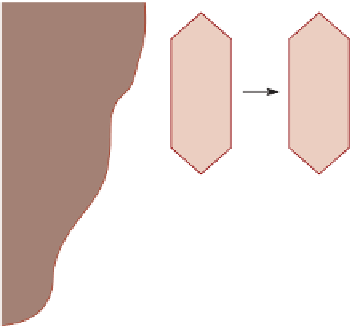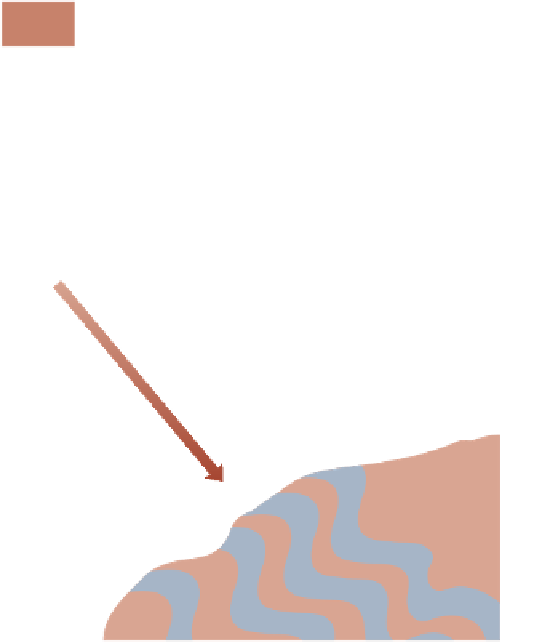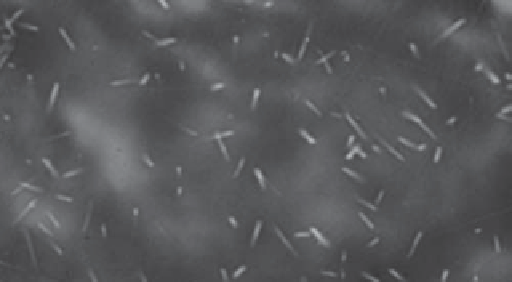Geology Reference
In-Depth Information
destroy one's sense of smell without careful handling. The
age of the sample is determined from the number of fi ssion
tracks present and the amount of uranium that the sample
contains: the older the sample, the greater the number of
tracks (
Igneous
rock
Figure 17.23).
Fission track dating
is of particular interest to archae-
ologists and geologists because the technique can be used to
date samples ranging from only a few hundred to hundreds
of millions of years old. It is most useful for dating samples
between approximately 40,000 and 1.5 million years ago, a
period for which other dating techniques are not always par-
ticularly suitable. One of the problems in fi ssion track dat-
ing occurs when the rocks have later been subjected to high
temperatures. If this happens, the damaged crystal structures
are repaired by annealing, and consequently the tracks dis-
appear. In such instances, the calculated age will be younger
than the actual age.
◗
700
MYA
400
MYA
a
b
Metamorphism
350
MYA
Present
c
d
Carbon is an important element in nature and is one of the
basic elements found in all forms of life. It has three isotopes;
two of these, carbon 12 and 13, are stable, whereas carbon
14 is radioactive (see Figure 3.4). Carbon 14 has a half-life
of 5730 years plus or minus 30 years. The
carbon-14 dating
technique
is based on the ratio of carbon 14 to carbon 12
and is generally used to date formerly living material.
The short half-life of carbon 14 makes this dating tech-
nique practical only for specimens younger than about
70,000 years. Consequently, the carbon-14 dating method
is especially useful in archaeology and has greatly helped
unravel the events of the latter portion of the Pleistocene
Epoch. For example, carbon-14 dates of maize from the
Tehuacan Valley of Mexico have forced archaeologists to
rethink their ideas of where the first center for maize do-
mestication in Mesoamerica arose. Carbon-14 dating is also
helping to answer the question of when humans began pop-
ulating North America.
Metamorphic
rock
◗
Figure 17.22
Effects of Metamorphism on Radiometric
Dating The effect of metamorphism in driving out daughter atoms
from a mineral that crystallized 700 million years ago (mya). The
mineral is shown immediately after crystallization
a
, then at
400 million years
b
, when some of the parent atoms had decayed
to daughter atoms. Metamorphism at 350 mya
c
, drives the
daughter atoms out of the mineral into the surrounding rock.
If the rock has remained a closed chemical system throughout
its history, dating the mineral today
d
, yields the time of
metamorphism, whereas dating the whole rock provides the
time of its crystallization, 700 mya.
meteorites. The rubidium-strontium pair is also used for very
old samples and has been effective in dating the oldest rocks
on Earth, as well as meteorites.
The potassium-argon method is typically used for dat-
ing fi ne-grained volcanic rocks from which individual crys-
tals cannot be separated; hence, the whole rock is analyzed.
Because argon is a gas, great care must be taken to ensure
that the sample has not been subjected to heat, which would
allow argon to escape; such a sample would yield an age that
is too young. Other long-lived radioactive isotope pairs ex-
ist, but they are rather rare and are used only in special
situations.
The emission of atomic particles that result from the sponta-
neous decay of uranium within a mineral damages its crystal
structure. The damage appears as microscopic linear tracks
that are visible only after the mineral has been etched with
hydrofluoric acid, an acid so powerful that its vapors can
◗
Figure 17.23
Fission Track Dating Each fi ssion track (about
16 microns [
=
16/1000 mm] long) in this apatite crystal is the
result of the radioactive decay of a uranium atom. The apatite
crystal, which has been etched with hydrofl uoric acid to make the
fi ssion tracks visible, comes from one of the dikes at Shiprock,
New Mexico, and has a calculated age of 27 million years.






























Search WWH ::

Custom Search